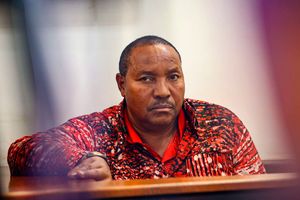Somalia, Kenya dispute: What ICJ judgment says
The UN's top court awarded Somalia control of most of a potentially oil and gas-rich chunk of the Indian Ocean on Tuesday after a bitter legal battle with Kenya over their sea border.
The International Court of Justice (ICJ) ruled there was "no agreed maritime boundary" and drew a new border close to the one claimed by Somalia, although Kenya kept a part of the 100,000 square-kilometre area, chief judge Joan Donoghue said.
Kenya, which had claimed the entire area off the East African coast, said last week that it would refuse to recognise the jurisdiction of the "biased" Hague-based court.
The court's decision, which is final, could have far-reaching consequences for the future of relations between two key countries in one of the world's most troubled regions.
Somalia dragged Kenya to the ICJ in 2014 over the disputed patch of sea.

Kenya-Somalia maritime border dispute graphic.
At the heart of the dispute is the direction that the joint maritime boundary should take from the point where the land frontiers meet on the coast.
Somalia insisted the boundary should follow the orientation of its land border and thus head out in a 200 nautical mile line towards the southeast.
But Kenya said its boundary runs in a straight line due east -- a delineation that would have given it a big triangular slice of the sea.
The court in the end drew a line passing closer to the boundary claimed by Somalia.
Nairobi says it has exercised sovereignty over the area since 1979, when it proclaimed the limits of its exclusive economic zone (EEZ) -- a maritime territory where a state has the right to exploit resources.
The contested 100,000-square-kilometre (38,000-square-mile) area is believed to contain rich gas and oil deposits, and also has important fishing rights.
Nairobi has already granted exploration permits to Italian energy giant ENI but Somalia is contesting the move.
Rulings by the ICJ, which was set up after World War II to resolve disputes between UN member states, are binding and cannot be appealed.
The court has no overt means of enforcing judgments but can refer violations to the United Nations.
Violation of obligations
The ICJ dismissed a claim made by Somalia that Kenya violated its international obligations by exploring minerals at a disputed maritime area in the Indian Ocean.
The court also declined to examine Somalia’s request for reparations over alleged illegal activities by Kenya that occurred after 2009 when the two countries were in negotiations over the dispute.
Further, it also found that Kenya did not interfere with Somalia's sovereignty and that it cannot be concluded that the activities carried out by Kenya in the disputed area jeopardised or hampered the reaching of a final agreement on the delimitation of the maritime boundary.
Drilling activities
Somalia had complained of certain drilling activities, which it said could lead to permanent physical changes in the marine environment. It argued that such activities may alter the status quo between the parties and could jeopardise or hamper the reaching of a final agreement.
But the court noted that a presentation made in 2011 by a commissioner from Kenya’s Ministry of Energy refers to offshore drilling operations in the Lamu Basin but only lists wells drilled until 2007.
“A map included in the Final Report of the Strategic Environmental and Social Assessment of the Petroleum Sector in Kenya, issued in December 2016 by the Ministry of Energy and Petroleum of Kenya, identifies four wells drilled in the Lamu Basin after 2009, but all of them are located south of and at a great distance from the equidistance line claimed by Somalia as the maritime boundary,” said the judges.
The map does not show any wells drilled after 2009 in the oil concession blocks referred to by Somalia.
Somalia alleged that there was drilling in Block L-22, within the disputed area.
However, two documents issued by a private operator state that “sea core drilling operations were in progress on the L22 offshore license” in 2013 and that “on the offshore L22 license, seabed core drilling operations were carried out in early 2014”.
The judges observed that these documents do not specify the precise location of those operations.
As for the alleged drilling in Block L-5, Somalia failed to provide the court with evidence demonstrating that any such drilling operation ever took place.
“Thus, on the basis of the evidence before it, the Court is not in a position to determine with sufficient certainty that drilling operations that could have led to permanent physical change in the disputed area took place after 2009,” ruled the judges.
Somalia referred to four wells drilled in the offshore Lamu Basin as of 2011, to “sea core” and “seabed core” drilling operations carried out in Block L-22 in 2013 and 2014, and to exploratory drilling in Block L-5 which was “scheduled in 2015”.
On its part, Kenya did not deny having authorised drilling operations in the Lamu Basin, but stated that “there was no drilling of seabed core” in Block L-22 in 2014 and that the drilling scheduled in Block L-5 “never took place”.
The court further noted that, in 2014, the two countries engaged in negotiations on maritime delimitation and that, in 2016, Kenya suspended its activities in the disputed area and offered to enter into provisional arrangements with Somalia.






